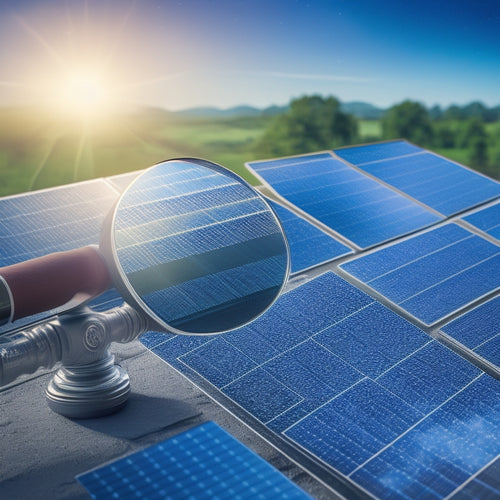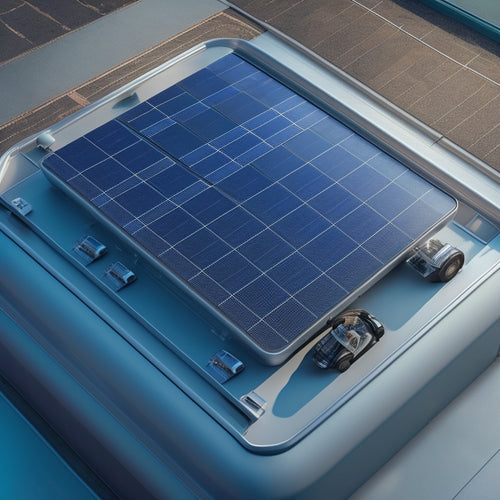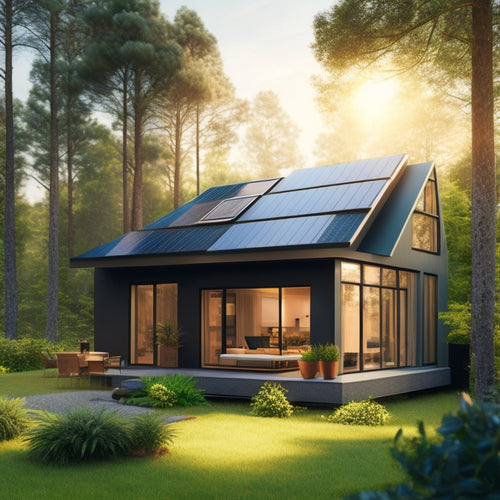
How to Install Solar Power at Home in 3 Easy Steps
Share
You'll start by evaluating your energy needs, analyzing past utility bills to determine your average daily energy usage in kWh and considering factors like occupancy, appliances, and lighting. Next, you'll choose the right equipment, selecting solar panels, inverters, and a mounting system that fit your energy needs and roof size. Finally, you'll install and connect the panels, ensuring a secure and optimized setup that maximizes energy production - and with these 3 easy steps, you'll be well on your way to utilizing the power of the sun, and there's more to investigate on the path to a fully functional solar power system.
Key Takeaways
- Assess your energy needs by analyzing past utility bills and accounting for energy consumption patterns to determine the required solar power generation.
- Choose the right equipment, including solar panels, inverters, and mounting systems, based on your energy needs, roof size, and system complexity.
- Ensure optimal panel placement, tilt, and connection to maximize energy production, following manufacturer's instructions and local electrical codes.
- Invest in monitoring systems to track production, consumption, and overall system performance to ensure efficient energy usage.
- Consider factors like shading, tracking systems, and weather-tight wiring connections to optimize your solar power installation.
Assess Your Energy Needs
Your energy usage serves as the foundation for determining the size and scope of your solar power system. To accurately evaluate your energy needs, you'll need to calculate your total energy consumption. This involves analyzing your past utility bills to identify your average daily energy usage in kilowatt-hours (kWh).
You'll want to take into account factors like the number of occupants in your home, the type and number of appliances, and your lighting usage. Understanding your energy consumption patterns will help you determine how much solar power you need to generate.
You'll need to take into account the solar efficiency of the system, which is affected by factors like the type and quality of the solar panels, the amount of sunlight your location receives, and the system's conversion efficiency.
Choose the Right Equipment
Selecting the appropriate solar power equipment is essential to guarantee a reliable and efficient system. You'll need to choose the right components that match your energy needs and budget.
-
Solar Panel Types: Decide on the type of solar panels that suit your roof's size and energy requirements. Monocrystalline, polycrystalline, and thin-film panels are popular options, each with their pros and cons.
-
Inverter Options: Inverters convert DC power from your solar panels to AC power for your home. You can choose from string inverters, microinverters, or power optimizers, depending on your system's size and complexity.
-
Mounting and Tracking Systems: Select a mounting system that securely fastens your solar panels to your roof, ensuring peak energy production. You may also consider tracking systems to adjust panel angles for maximum energy output.
- Monitoring and Control Systems: Invest in a monitoring system that tracks your solar power production, energy consumption, and system performance. This helps you identify areas for improvement and enhance your energy usage.
Install and Connect Panels
With your equipment in hand, it's time to install and connect your solar panels.
First, you'll need to determine the ideal panel placement on your roof. Verify the panels face the correct direction (south in the northern hemisphere) and are tilted at the best angle (between 30 and 40 degrees) to maximize energy production. Take care to avoid shading from trees, chimneys, or other obstructions.
Next, you'll connect the panels to each other and to the mounting system. Use weather-tight wiring connections to link the panels in series and parallel configurations.
Make certain to follow the manufacturer's instructions and local electrical codes. Connect the panels to the inverter, which converts DC power to AC power for your home.
Frequently Asked Questions
Can I Install Solar Panels on a Rented Property?
Can you utilize the sun's energy on someone else's turf? It's possible, but you'll need to contemplate rented property limitations and investigate solar panel options that don't require permanent installation, like removable panels or community solar programs.
How Do I Maintain and Clean My Solar Panels?
You'll guarantee ideal energy harvesting by performing regular panel maintenance, including gentle cleaning with a soft-bristled brush and distilled water, and inspecting for debris, to prevent efficiency losses and maximize your solar power output.
Are Solar Panels Affected by Weather Conditions?
You'll be surprised to know that solar panels can still generate 50% of their peak power on cloudy days! However, you'll experience a weather impact on solar panel efficiency, with extreme temperatures, humidity, and shading affecting performance, so it's essential to monitor and adjust accordingly.
Can I Use Solar Power During a Blackout?
You can utilize solar power during a blackout by investing in a solar battery, ensuring grid independence and uninterrupted energy supply, as it stores excess energy generated during the day for later use.
Will Solar Panels Increase My Property Value?
You'll reap significant property value benefits from your solar panel investment, as it can increase your home's worth by up to 17%, making it more attractive to potential buyers and enhancing your resale value.
Related Posts
-

Solar Panel System Certification Costs: A 10-Point Breakdown
You're looking to understand the costs associated with solar panel system certification. Your total certification cos...
-

Top Solar Panels for Car Battery Maintenance
When selecting top solar panels for car battery maintenance, consider high-efficiency models with high wattage output...
-

Reduce Solar Panel Cost for Your Small Home
By evaluating your energy needs, choosing the right installer, and selecting cost-effective solar panel options, you ...


